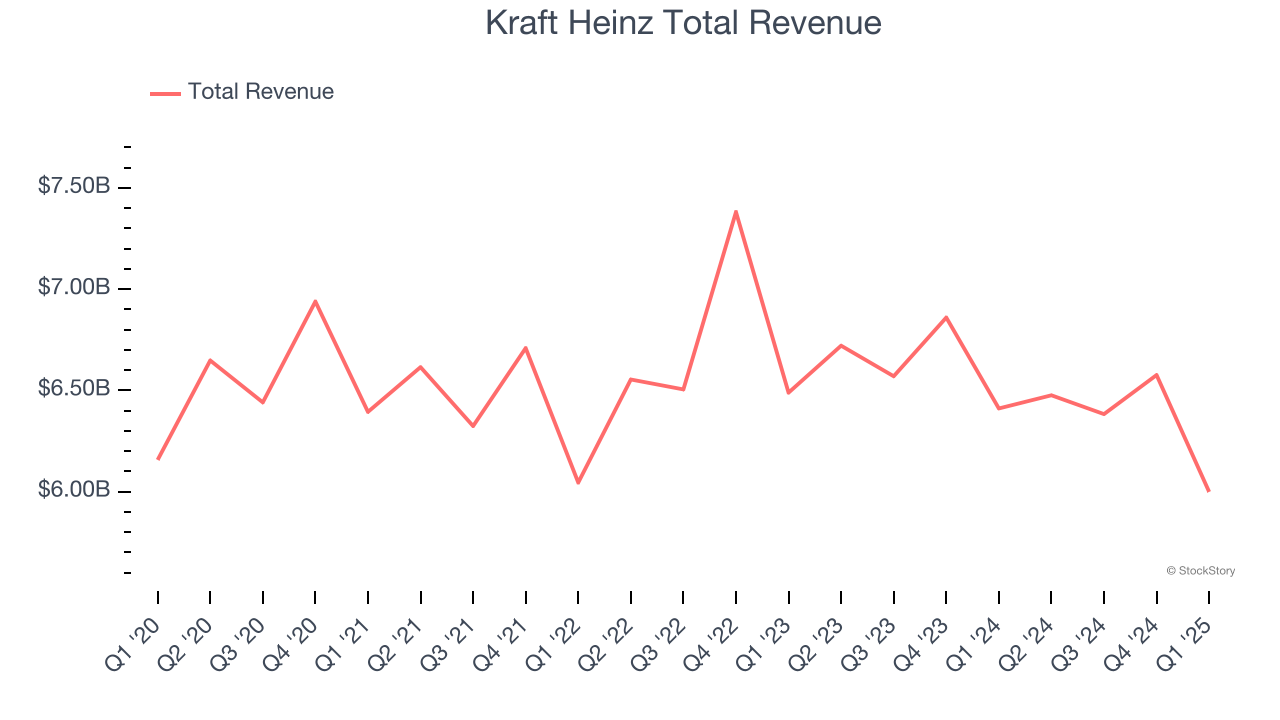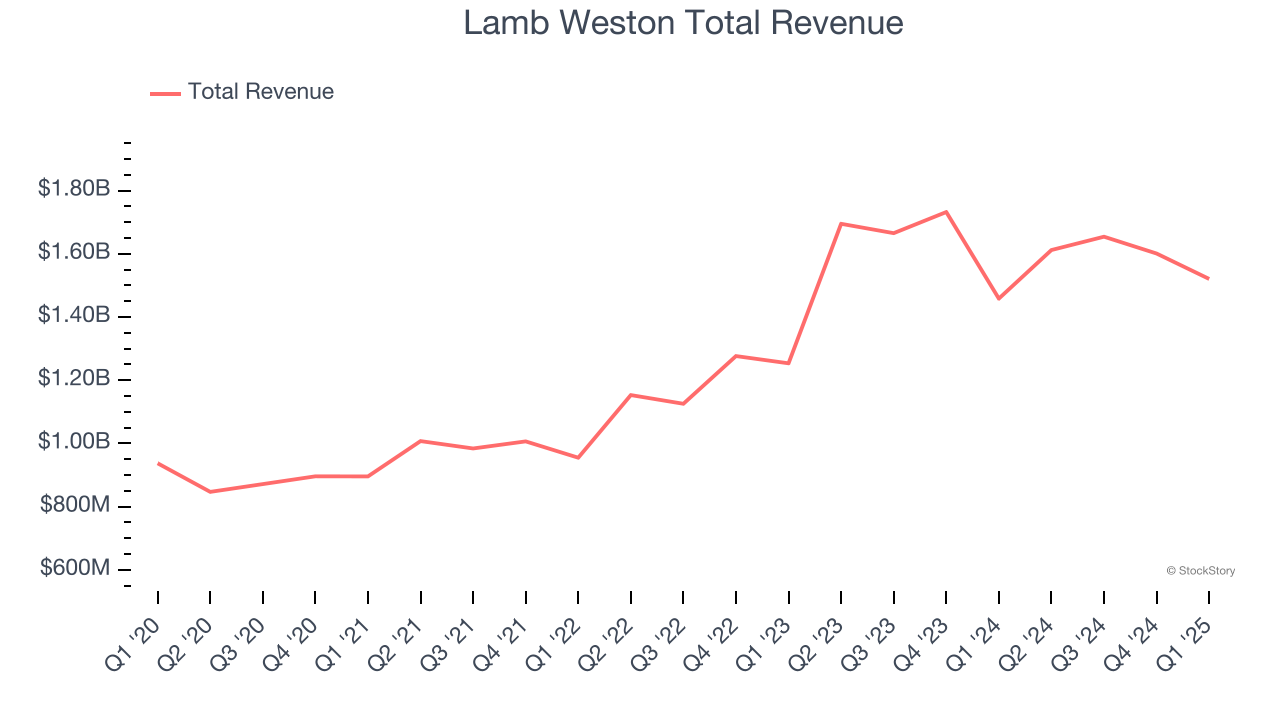
Let’s dig into the relative performance of Kraft Heinz (NASDAQ: KHC) and its peers as we unravel the now-completed Q1 shelf-stable food earnings season.
As America industrialized and moved away from an agricultural economy, people faced more demands on their time. Packaged foods emerged as a solution offering convenience to the evolving American family, whether it be canned goods or snacks. Today, Americans seek brands that are high in quality, reliable, and reasonably priced. Furthermore, there's a growing emphasis on health-conscious and sustainable food options. Packaged food stocks are considered resilient investments. People always need to eat, so these companies can enjoy consistent demand as long as they stay on top of changing consumer preferences. The industry spans from multinational corporations to smaller specialized firms and is subject to food safety and labeling regulations.
The 18 shelf-stable food stocks we track reported a slower Q1. As a group, revenues missed analysts’ consensus estimates by 1% while next quarter’s revenue guidance was 0.6% above.
Amidst this news, share prices of the companies have had a rough stretch. On average, they are down 5.2% since the latest earnings results.
Kraft Heinz (NASDAQ: KHC)
The result of a 2015 mega-merger between Kraft and Heinz, Kraft Heinz (NASDAQ: KHC) is a packaged foods giant whose products span coffee to cheese to packaged meat.
Kraft Heinz reported revenues of $6.00 billion, down 6.4% year on year. This print was in line with analysts’ expectations, but overall, it was a mixed quarter for the company with a narrow beat of analysts’ EBITDA estimates but full-year EPS guidance missing analysts’ expectations.

Unsurprisingly, the stock is down 2.2% since reporting and currently trades at $28.15.
Read our full report on Kraft Heinz here, it’s free.
Best Q1: Lamb Weston (NYSE: LW)
Best known for its Grown in Idaho brand, Lamb Weston (NYSE: LW) produces and distributes potato products such as frozen french fries and mashed potatoes.
Lamb Weston reported revenues of $1.52 billion, up 4.3% year on year, outperforming analysts’ expectations by 2.4%. The business had a very strong quarter with a solid beat of analysts’ EBITDA estimates and an impressive beat of analysts’ gross margin estimates.

Lamb Weston delivered the highest full-year guidance raise among its peers. Although it had a fine quarter compared its peers, the market seems unhappy with the results as the stock is down 5.2% since reporting. It currently trades at $51.31.
Is now the time to buy Lamb Weston? Access our full analysis of the earnings results here, it’s free.
Weakest Q1: B&G Foods (NYSE: BGS)
Started as a small grocery store in New York City, B&G Foods (NYSE: BGS) is an American packaged foods company with a diverse portfolio of more than 50 brands.
B&G Foods reported revenues of $425.4 million, down 10.5% year on year, falling short of analysts’ expectations by 6.8%. It was a disappointing quarter as it posted a significant miss of analysts’ adjusted operating income estimates.
B&G Foods delivered the weakest performance against analyst estimates in the group. As expected, the stock is down 28.7% since the results and currently trades at $4.50.
Read our full analysis of B&G Foods’s results here.
McCormick (NYSE: MKC)
The classic red Heinz ketchup bottle’s competitor, McCormick (NYSE: MKC) sells food-flavoring products like condiments, spices, and seasoning mixes.
McCormick reported revenues of $1.61 billion, flat year on year. This number missed analysts’ expectations by 0.6%. It was a slower quarter as it also produced a miss of analysts’ EBITDA and EPS estimates.
The stock is down 4.2% since reporting and currently trades at $76.90.
Read our full, actionable report on McCormick here, it’s free.
BellRing Brands (NYSE: BRBR)
Spun out of Post Holdings in 2019, Bellring Brands (NYSE: BRBR) offers protein shakes, nutrition bars, and other products under the PowerBar, Premier Protein, and Dymatize brands.
BellRing Brands reported revenues of $588 million, up 18.9% year on year. This print surpassed analysts’ expectations by 1.6%. Zooming out, it was a mixed quarter as it also recorded an impressive beat of analysts’ organic revenue estimates but a significant miss of analysts’ gross margin estimates.
BellRing Brands achieved the fastest revenue growth but had the weakest full-year guidance update among its peers. The stock is down 18% since reporting and currently trades at $64.33.
Read our full, actionable report on BellRing Brands here, it’s free.
Market Update
In response to the Fed’s rate hikes in 2022 and 2023, inflation has been gradually trending down from its post-pandemic peak, trending closer to the Fed’s 2% target. Despite higher borrowing costs, the economy has avoided flashing recessionary signals. This is the much-desired soft landing that many investors hoped for. The recent rate cuts (0.5% in September and 0.25% in November 2024) have bolstered the stock market, making 2024 a strong year for equities. Donald Trump’s presidential win in November sparked additional market gains, sending indices to record highs in the days following his victory. However, debates continue over possible tariffs and corporate tax adjustments, raising questions about economic stability in 2025.
Want to invest in winners with rock-solid fundamentals? Check out our Top 5 Quality Compounder Stocks and add them to your watchlist. These companies are poised for growth regardless of the political or macroeconomic climate.
Join Paid Stock Investor Research
Help us make StockStory more helpful to investors like yourself. Join our paid user research session and receive a $50 Amazon gift card for your opinions. Sign up here.







